#toei animation mononoke
Explore tagged Tumblr posts
Text
He(?).
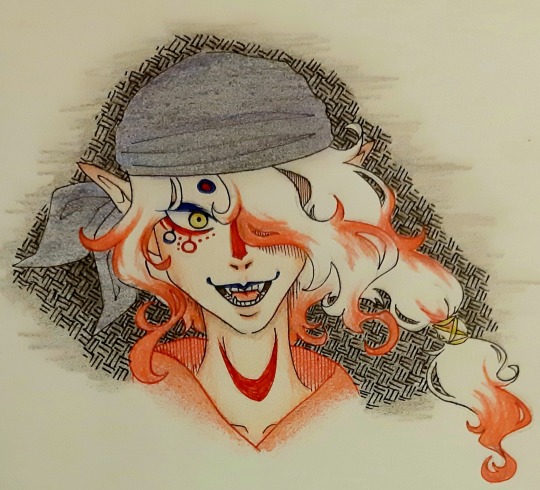
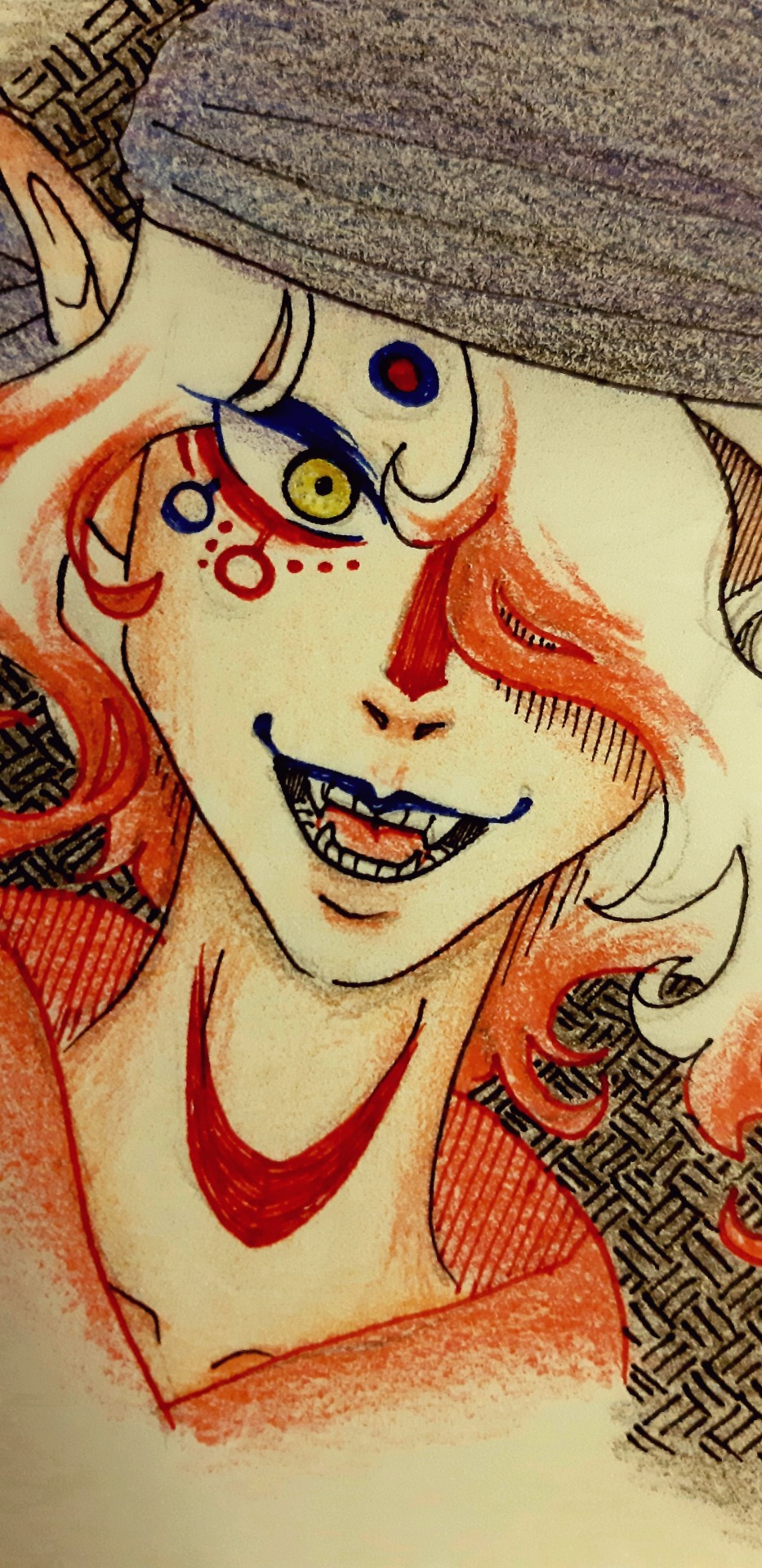
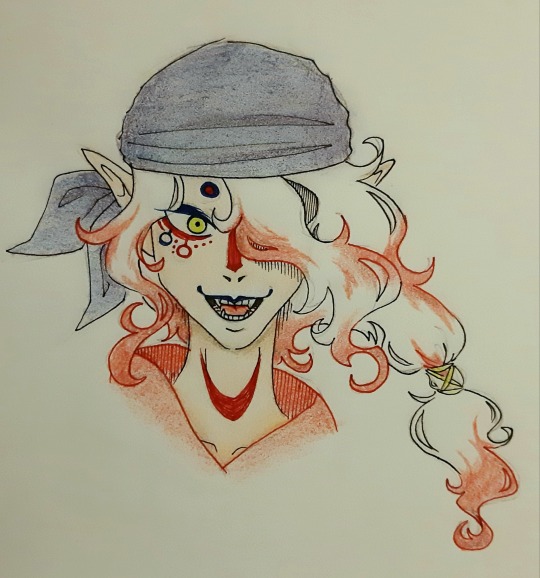
I fuckinh cant with his design aæeeuuughhhhghhghgghhh *combusts*
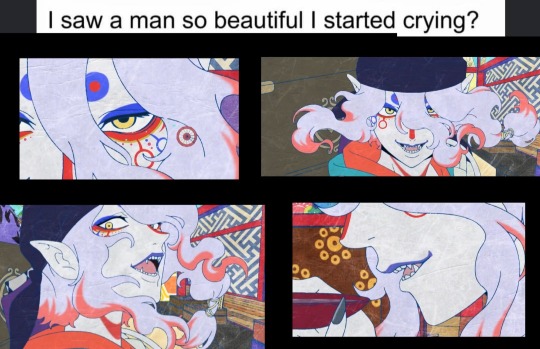
#mononoke 2024#kusuriuri#medicine seller#Fanart#i saw a man so beautiful i started crying#Damn I should've taken more wip-pics but I forgor#Kinda regret the bg but oh well#I think I'm ace but if he keeps just existing & looking like that.. imma act up (the original kusuriuri was already too much)#The animation in Mononoke makes me nut for real for real (cant wait for more the trailer looks so gooood)#toei animation mononoke#hes so pretty
78 notes
·
View notes
Text
Best show ever, in terms of visuals😤
Anime: Mononoke


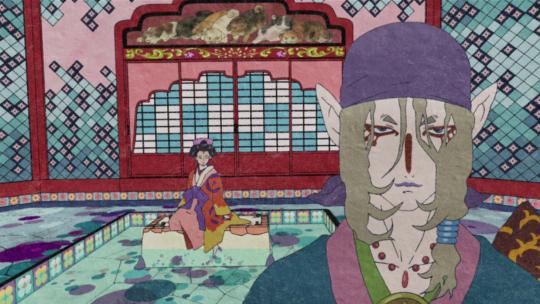




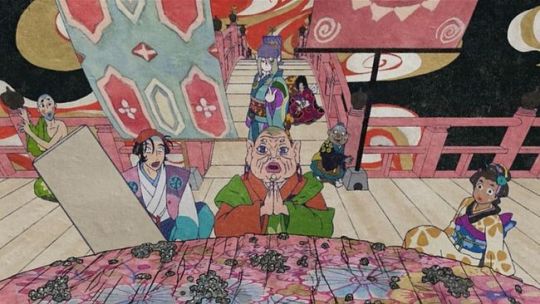

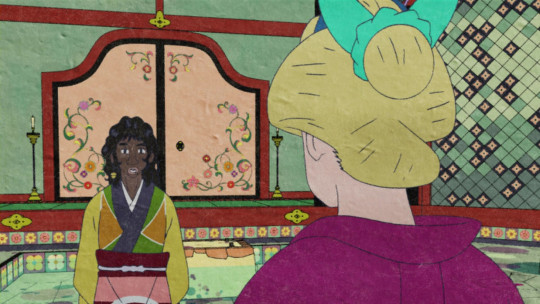
#mononoke 2007#mononoke#supernatural#horror#horror tv shows#supernatural tv show#art#colorful#must watch#masterpiece#anime#horror anime#supernatural anime#toei#toei animation
187 notes
·
View notes
Text
It's 5:40am, I'm currently so tired that I've gone full circle and now have energy again ✌🏾soooo...
Today's gender is voiced by Colleen Clinkenbeard and animated by Toei Animation

(^^ If you actually know the show in this gif I am platonically in love with you)





#i know icarus isn't in dbz kai but gohan looks adorable in this gif#gender#genderqueer#anime#animation#voice acting#voice actors#animated by#voiced by#gender of the day#toei animation#colleen clinkenbeard#kyousougiga#toriko#mononoke 2007#koto kyousougiga#mononoke kusuriuri#kusuriuri#monkey d. luffy#straw hat luffy#one piece#marie mjolnir#soul eater#son gohan#dbz gohan#dbz kai#dragon ball z
16 notes
·
View notes
Text
♡

#mononoke#mononoke anime#mononoke 2007#medicine seller#toei animation#ghost story#psychological horror#mystery#anime#art
47 notes
·
View notes
Text
Quotorium Reviews: Mononoke
I haven't written a review in several years thanks to a burnout-induced hiatus, but I'm back with Mononoke!
#anime#anime review#ayakashi#ayakashi samurai horror tales#ayakashi: samurai horror tales#featured#mononoke#mononoke 2007#mononoke hinezumi#mononoke karakasa#mononoke movie#mononoke review#mononoke the phantom in the rain#the phantom in the rain#toei animation#twin engine#year of anime
2 notes
·
View notes
Text
Mononoke: A Thought Provoking Series
Mononoke TV Anime Review: A Thought-Provoking Series #mononoke #anime #モノノ怪 #horror #Television
With the new movie getting ready to debut in Japan, the newest review will be focusing on the Television Anime, Mononoke. Also, for an in-depth look at this series, be sure to check out Crunchyroll’s newest feature from Adam Wescott. The series takes place between the Edo period and the Meiji period, an era that had a four-class system: a samurai was considered to be the highest class, and…
#Anime#Ayakashi#Ayakashi Samurai Horror Tales#モノノ怪#Fantasy#Gekijōban Mononoke Karakasa#Ghost Stories#Mononoke#Psychological Horror#Toei Animation#Yokai
0 notes
Text
Mononoke Zine WIP Preview

Given that the new Mononoke movie "Karakasa/Phantom in the Rain" is now on Netflix, it's perfect time to share this.
🎨 Here's a WIP teaser of 2 paintings I illustrated for the upcoming Mononoke zine 📖!
The physical print zine will be made available for preorder. If you're interested in updates, please follow the zine project @mononoke-zine.
Mononoke © Toei Animation Artwork © EerieAyres
#artists on tumblr#mononoke#mononoke fanart#kusuriuri#mononoke kusuriuri#medicine seller#mononoke medicine seller#mononoke anime#mononoke 2007#mononoke 2024#karakasa#mononoke karakasa#mononoke phantom in the rain#モノノ怪#薬売り#モノノ怪 fa#zine#fanzine#zine preview#wip
274 notes
·
View notes
Note
just wanted to drop in to say hi! and just, there's something so wonderfully charming about your blog. it almost fills me with nostalgia, like how it was back when fandom stuff was mostly confined to the likes of livejournal and ff.net
anyway, happy end of year holidays friend 🧡 may next year bring us lots of anime-related, or unrelated joys. also, if you don't mind sharing your thoughts, what shows are you excited for next year? i'm particularly freaking out about a lot of season 2 stuff like kusuriya and my happy marriage! but other than that there seems to be so much to look forward to next year 🥰🥰
Omg, thank you so much.
I’ve been in this hellhole of a site for 12 whole years but I was already lurking for more than a year before I decided to join. So I’ve been around for 13 to 14 years, give or take. And I really feel nostalgic, now more than ever, about how it used to be at the beginning. This place was peak for creativity and just having fun with stuff anonymously, no strings attached. It was paradise, and still is, but now with way less people and way less traction. I’ve been careful to keep my editing style consistent for all these years so that I’d still remember the trends from Way Back. I’m glad it has the same effect on other people. So, know that your message has warmed up my heart! 💕
Happy year end holidays to you too! I’m sorry if I’m replying late to this! I hope the time difference wasn’t too big. 😭❤️
There’s actually a lot that I’m looking forward to next year! First of all, Tongari Boushi no Atelier and Hikaru ga Shinda Natsu! Secondly, the anime adaptation of City (I think KyoAni can’t possibly fuck this one up, it’s animation-focused with very little plot, so basically their forte) and the remake of Jigoku Sensei Nube (when the official Toei channel started broadcasting Nube as a 30-year anniversary commemoration, I could SMELL the remake coming and have not been normal ever since). Speaking of remake, there sure is a lot of remakes next year! There’s the remake of Anne of Green Gables, Versailles no Bara, As for the rest, Medalist, Witch Watch, Kowloon Generic Romance, Chuuzenji-sensei no Mononoke Kougiroku, Sakamoto Days and Dekin no Mogura.
Ofc, I’m also looking forward to the many sequels! That includes Kusuriya and WataKon, but also Hanako-kun, Aharen-san, Kaijuu 8-gou, Dandadan, Shoushimin, Kuroshitsuji, Hyakushou Kizoku, 3-nen Z-gumi Ginpachi-sensei (can you even call this a sequel??? lol) and of course, the last season of HeroAca. So far, this is my list!
And yes! Hope the universe hears you! May next year be a blast!
9 notes
·
View notes
Text
Rewatched anime "Mononoke" (2007). Nostalgic jump into the Past. Because it is similar to "Monogatari" series and "Tatami Room", ect... Minus haram vibes. Short explain, same production of "Devilman Crybaby", minus splatter. Yes, it's violent, psychological and pretty much bloody (sometimes completely messed colours, sometimes the right colour but too much and it's definitely unnatural). Definitely need watching "Ayakashi: Japanese Classic Horror" (2006), made by Toei Animation.
Watched "Mononoke" (2024)... It's more "Summer Wars" and "Kemono no ko" vibes. Still psychedelic. Still so bright and colourful. And less chaotic. Main character looks different... It feels somehow right. Also oni hair is much into this type of narrative. Because the first version is more divine. The second version is more demonic. I feel it as if Love Machine from "Summer Wars".
I guess at the end of the season are missing the other three episodes. Looks good.
9 notes
·
View notes
Text
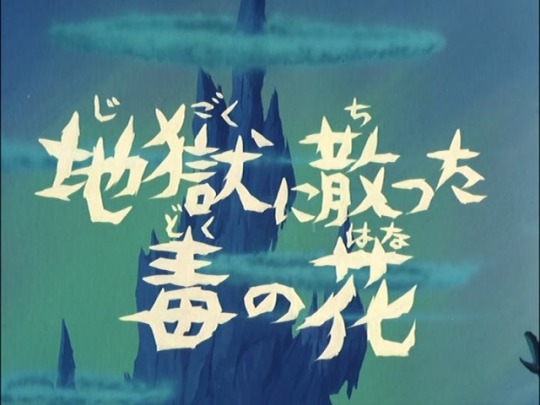
Let's conclude our Cutie Honey 50th anniversary trivia with the final episode: “A Poison Flower Falls to Hell.”
Screenwriter: Masaki Tsuji
Art Director: Urata Mataharu
Animation Director: Satoshi Jingu
Director: Osamu Kasai
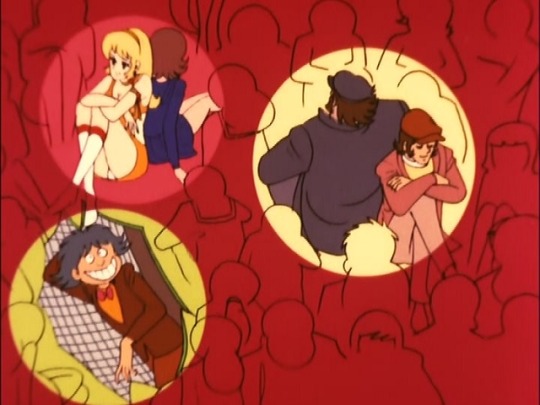
With the exception of Junpei’s girlfriend Mami and the nameless Panther Claw subordinates, all of the (living) characters in the series appear for the final episode.
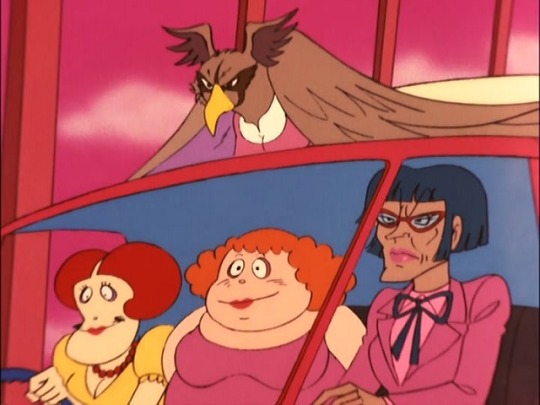
The suspenseful drumming that plays before Eagle Panther attacks the truck was lifted from Go Misawa’s soundtrack for Devilman.

Honey's final "Honey Flash" animation was recycled from episode 22. Only the background was changed.
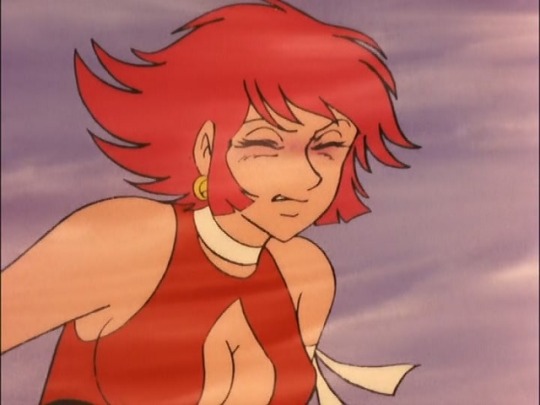
Honey has always lovingly addressed her father as “papa”, but in this episode she refers to him as the more formal otousama or “father.” This was probably done to demonstrate to the audience how much she has grown from her battle with Panther Claw.
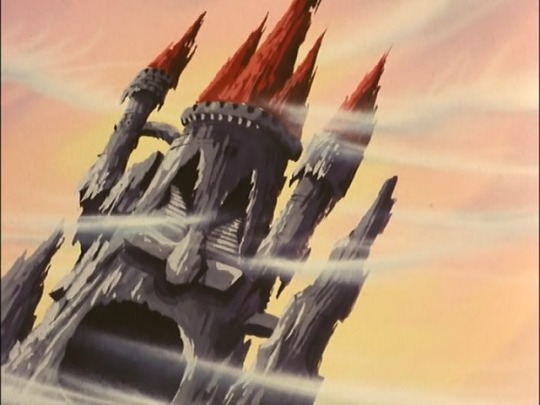
In the original manga, Sister Jill’s headquarters was called maboroshi jyou or “Castle of Illusion.” The name was probably changed to avoid confusion with Cutter Claw’s “Castle of Illusion” from episode 10.
Jill’s headquarters in the manga looks like a traditional European style castle, while the anime version evokes more of a haunted house.
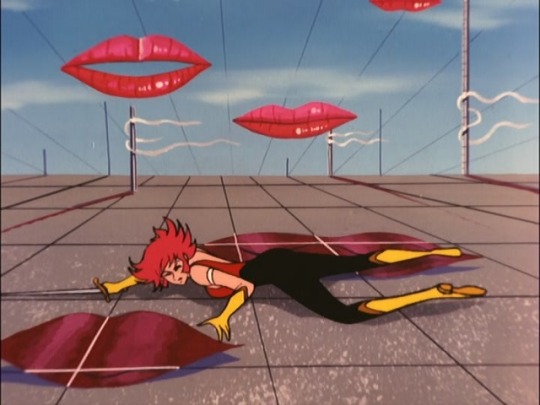
The dreamlike landscape Honey falls into is modeled after the surrealist works of Salvador Dali, specifically one of his most famous works, The Persistence of Memory, which depicts melting pocket watches. The floating lips could possibly be based on Man Ray’s Observatory Time: The Lovers, a painting featuring a giant pair of lush red lips in the sky.
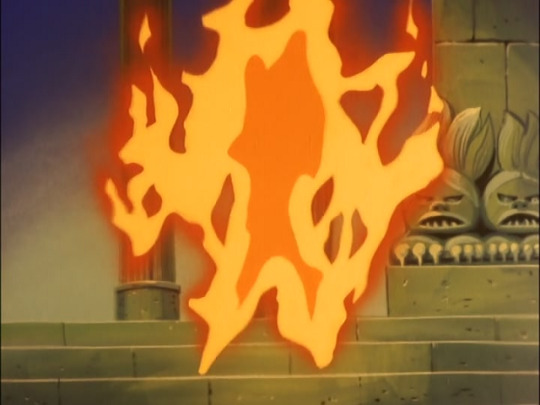
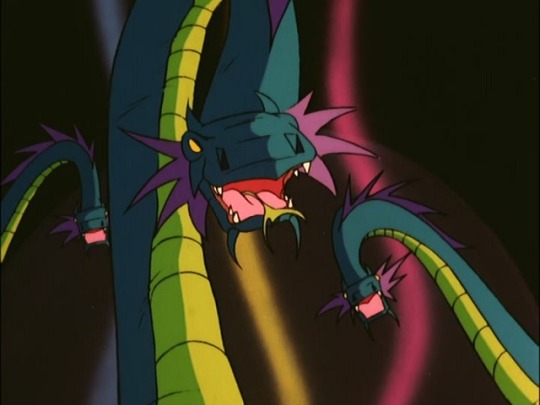
The second half of the episode features a few references to one of Toei Animation’s earlier films, The Little Prince and the Eight-Headed Dragon.
Released in 1963, the film tells the story of Susanoo, the youngest son of the gods who created the Earth, and his journey in finding his mother. The stylized film featured the talents of animation veterans such as Yasuo Otsuka, Yoichi Kotabe, Isao Takahata, and Kimio Yabuki.
References to The Little Prince and the Eight-Headed Dragon:
The human shaped fire that attacks Honey is animated almost exactly like the Fire God that Susanoo faces.
The phantom serpents are a dead-ringer for the eight-headed dragon. The only difference is the coloring. In the film their colors are similar to Maleficent's dragon form from Walt Disney’s Sleeping Beauty. It’s worth mentioning in the original storyboard the illusions were meant to look like generic snakes.
After the Panther Chateau crumbles, the gloomy skies clear up and Honey finds herself in a flowerbed under a blue sky. This is similar to the end of the film, in which the defeated dragon turns into a field of flowers and the dark skies become bright and sunny.

The serpents with humanoid faces were voiced by Nobuyo Tsuda, the same actress who plays Hystler and Panther Zora.
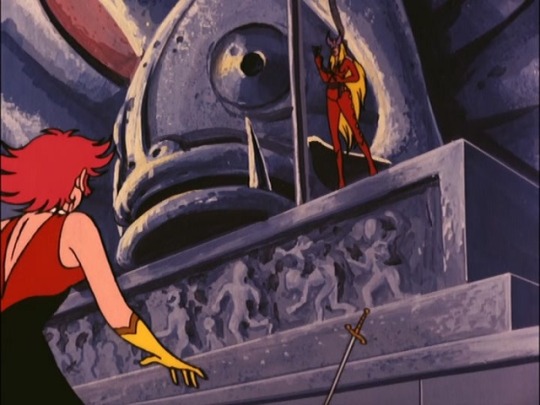
The bone-chilling organ music that plays during Honey and Jill’s confrontation is Fugue in D Major, BWV 580 by Johann Sebastian Bach. The rendition featured in this episode was performed by French organist Marie-Claire Alain.
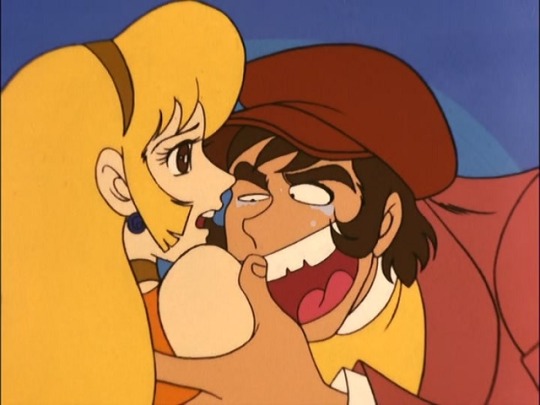
While the animation director for the finale is Satoshi Jingu of Anime Room, the key animation for the second half of the episode was handled primarily by Yoshinori Kanada. While he was relatively unknown at the time, he would go on to be a very influential figure in the animation world, working on titles such as Dino Mech Gaiking, Birth, Princess Mononoke and others. Kanada’s style is particularly noticeable during the “Honey Special” sequence and Honey's reunion with the Hayami family.
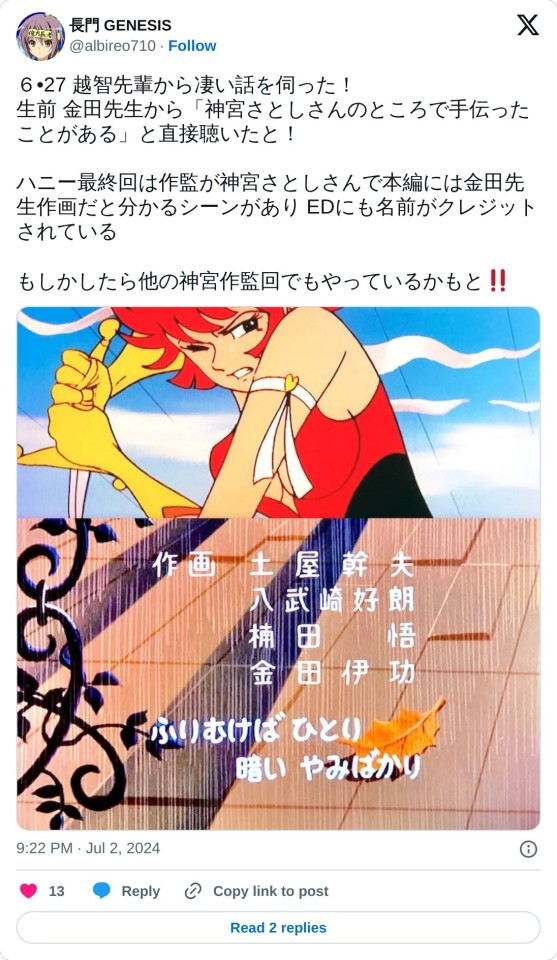
Although this is the only instance where Kanada is listed in the credits, Kazuhiro Ochi has confirmed he did in fact work on the other episodes that were animated by Anime Room (6, 13, 24, and 25).
Supposedly, the final episode was originally going to be handled by Shingo Araki and Hiroshi Shitara, but both men were too busy working on Majokko Megu-chan.

The original storyboard describes clouds around a mountain changing into the form of Panther Zora during the closing scenes. In the finalized episode, Zora simply appears in the sky.
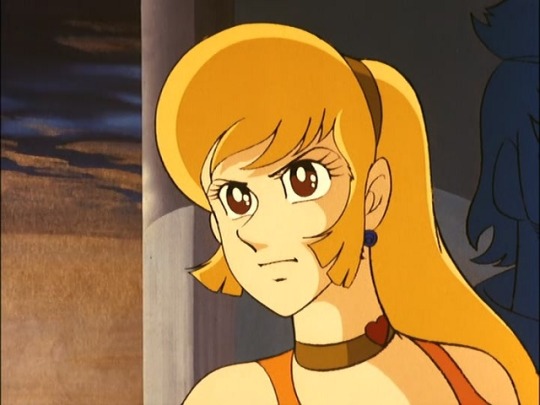
Despite getting pretty good ratings, Cutie Honey was canceled due to concerns over salacious content. According to Go Nagai’s autobiographical manga, Gekiman! Cutie Honey Hen, nearly everyone involved was blindsided by the cancellation. Toshio Katsuta in particular was quite surprised, since Honey made better ratings than its predecessor, Microid S. Katsuta was actually quite confident Honey would last three or four seasons.
Because of the series' abrupt cancellation, Katsuta and Nagai both agreed to have Honey defeat Jill at the end of the series, while leaving Panther Zora’s fate being left to the interpretation of the fans.
In an interview printed in the 1981 Cutey Honey Roman Album, Go Nagai talks a little bit about what Honey and Zora were up to after the finale. He says Zora began harvesting animals from the Amazon and transforming them into androids, probably in preparation for a battle against Honey. He also says Honey is destined to only fight Panther Claw, so she'd probably ignore any unrelated criminal activity. I guess we can assume Honey got a little downtime after her victory against Sister Jill?
And that's all our trivia for Cutie Honey! I hope you enjoyed all the interesting tidbits I've collected over the years. Maybe someday I'll do this for the other series...

Special Thanks:
@brickme
Ayumi Shinozaki
Josh M.
Charlie from Skaro Hunting Society
Phix Cabral
Jonathan Castleman
16 notes
·
View notes
Text
A short review of Mononoke (2007) and Mononoke: Phantom in the Rain (2024)
I'd like to preface this review by quickly retelling about my excitement when I discovered that a feature film was being developed for the Mononoke (モノノ怪) animated series by Toei Animation, and what I enjoyed about the series.
I was ecstatic! I loved the cartoon, and have revisited it many times over the years. Although I have never read the manga or the light novel adaptations, mainly because much of the charm of the cartoon lies in its visual and audio storytelling.
Mononoke made clever use of its limited budget by mainly using stills, which gave it a characteristic creepiness and stiltiness. The art design also made a creative use of colour, using it to convey what the viewer ought to pay attention to, by contrasting it to an overall dimmer palette. Overall, the backgrounds are also rich in detail, and many convey another layer to the narration, and many times outright show you what happened before the narrative came to that as a spoken conclusion.
One scene, in the first arc (Zashiki Warashi), they give emphasis to the dialogue by having the camera follow it: the character of the Medicine Seller is talking with a pregnant woman, who alleged that something twisted a man 'round and round and round and round' to murder him. As they speak, the camera pans around them in a rough circle. This room also has many paintings, some of which hide further meaning than merely being embellishment, such as the prostitutes, or the fire painting for the crematorium.
The music does a phenomenal job in setting the tension of the scenes, and the sound effects in general are another strong point.
By far the weakest parts are the fight scenes, as they do not benefit from the cuts, angles, or the general tension of the story: it renders them clumsy and out of place. You could remove them from the narrative altogether, and it would likely be of great benefit, as then the mononoke and ayakashi would have to be exorcised in a manner more befitting of the tone of the rest of the cartoon.
The cartoon also uses the reactions of the characters to convey the horrors of the mononoke, rarely showing them outright. This is a positive, because the character design is overall pending for the caricaturesque, instead of the art style more traditionally associated with the medium. This allows them to express emotions more freely, in a manner easier to connect with, thanks to the expressive faces of the characters.
Typically, the cartoon starts the episodes out in a light-hearted or even-toned fashion, and as the mysteries are uncovered, the tone gets more tense, although never outright dramatic.
However, I would not recommend watching the Zashiki Warashi arc first, even though that is the order it is in. Each arc, which takes about two episodes, is entirely divorced from the rest of the series. Instead, I would recommend to start with the Nue arc, as it deals with lighter materials than the Zashiki Warashi arc. Furthermore, I would advise viewers with pregnancy or abortion triggers to avoid it altogether, particularly due to its needlessly cruel ending.
Concerning other possible triggers, I would also advise avoiding the Umibōzu arc: it contains an incestuous unrequited romance, and it implies on sexual abuse of a subordinate. At the end of the arc you discover that the incest was unilateral, and possibly not real, but the vast majority of the arc operates under the impression that it is. It is also one of the longest arcs of the series, totalling in three episodes, the other one being the Bakeneko arc.
The Noppera-bō arc deals with domestic abuse and violence, as well as child mistreatment and neglect, although that is implied more than shown. It, and the Zashiki Warashi, are the most chilling arcs, as they detail, to an uncomfortable degree, their themes.
The Nue arc is by far the lightest. It has a pleasant conclusion, and it would provide a good palate cleanser, if you watch the arcs in order. If you choose to start with it, it showcases much of what the series does with visual storytelling, pacing, and colour use, which makes it a good way to measure if it's something that you would enjoy.
The series closes off with the Bakeneko arc, which ends in a somewhat dissatisfying manner, as it is never shown that the culprit was punished. This is not a problem in the previous arcs. Also, I would recommend this to be the last arc, as it is set closer to the modern age, as opposed to the rest of the series, which is set in an unspecified feudal era.
Now, as to the film…
If I were to sum it up in one word, it would be 'confused'. Because only the director remained from the original crew, it is unsurprising that none of the interesting elements are present.
The story is boring, without any of the emotional charge it once carried, sanitised of its challenging elements. The art direction is entirely misguided, far too bright and visually confusing: at many points I had to take a break from it, as it was overwhelming even to my neurotypical self. There was no interesting use of the camera, and the sound design was nothing of note. The fight scenes are just as clumsy and bad as the series, if not worse, as there was more of it.
Indeed, the highlight was the ending, because it meant I could do something else.
Overall, I must say that I am no longer looking forward to the next films. It seems to me that Mononoke was, as a series, best left in the past, as something interesting to point at, reference and reflect. It does better as a horror story than many of the ones currently being told, including the film that's based on it.
#archive#review#spur-of-the-moment#I was angry at the film and wanted to articulate why#I kind of want to analyse each episode now#mononoke 2007#mononoke phantom in the rain#my writing
2 notes
·
View notes
Text






One of Japan’s most distinctive filmmakers, Hayao Miyazaki has earned acclaim and recognition for his anime features since his debut in 1979 with The Castle of Cagliostro.
Born in Tokyo City in the Empire of Japan, Miyazaki expressed interest in manga and animation from an early age, and he joined Toei Animation in 1963. During his early years at Toei Animation he worked as an in-between artist and later collaborated with director Isao Takahata.
In 1985 he co-founded Studio Ghibli, which has since become a major name in the worlds of animation and international filmmaking. His subsequent films included Nausicaä of the Valley of the Wind (1984), Castle in the Sky (1986), My Neighbor Totoro (1988), Princess Mononoke (1997), Howl’s Moving Castle (2004), Ponyo (2008) and The Wind Rises (2013). His 2001 feature, Spirited Away, won an Academy Award for Animated Feature. In 2014, he was chosen to receive an Honorary Award at the Academy’s Governors Awards.
13 notes
·
View notes
Text
youtube
▶️ Il primo trailer per il film di MONONOKE è qui e nonostante alcune sostituzioni all'interno dello staff, il mondo del Venditore di Medicine è affascinante come sempre! Il debutto è atteso per l'estate 2024.
La pellicola è diretta ancora una volta da Kenji Nakamura (Gatchaman Crowds, Kuuchuu Buranko, Tsuritama), già regista dell’originale serie tv di 12 episodi prodotta nel 2007 presso TOEI ANIMATION, che potete ancora trovare in streaming su VVVVID.
Il peculiare mistery sovrannaturale nasce come spinoff della precedente serie antologica dal titolo AYAKASHI: JAPANESE CLASSIC HORROR e ha come protagonista un enigmatico esorcista.
#mononoke#mononoke movie#kusuriuri#kenji nakamura#anime#film#giappone#mystery#supernatural#historical#mythology#psychological#suspense#animazione#trailer
8 notes
·
View notes
Note
Hi....If you don't mind, can I ask, what are your top 10 (or top 7) favorite media (can be books/ manga/ anime/movies/tv series)? Why do you love them? Sorry if you've answered this question before......Thanks....
These questions always have me like... do I know 10 of anything?
The order doesn't indicate anything, I will number them to keep track.
Gunnerkrigg Court by Tom Siddell- I could write that I love it because it has Coyote and end there because that'd be enough. But I also like so many of the characters Annie, Kat, Shadow and Robot, and Parley and Smit and like so so many of the characters. And most of all I love the world building and the story. God how amazingly it is set up.
Digger by Ursula Vernon- The black and white art style is stunning. The story and world building are just so so amazing. My inner anthropology enthusiast connects very deeply with this anthropology coded comic. And also it has Grim Eyes, and Ed and Shadow Child.
Blame! by Nihei Tsutomu - This is still the most beautiful comic I've seen. Idk what about it resonates with me so much but I regularly just like to open volumes at random and look at it. The concept is good too, don't get me wrong. And it's like a 10 vol manga that kinda has like 2 characters that matter and most pages don't have any dialogue or writing at all...
Every single piece of Kon Satoshi's - literally everything that man made is amazing. It's beautiful for one. But also everything he made was about perception of reality. About how reality is formed from the subjective human mind. How it is formed from imperfect memory and lack of full knowledge because it's impossible to have all the information. etc. He hasn't made much, his life was cut far too short. You can watch everything in a week and you should.
The Pillow Book by Sei Shounagon - This book is such a vibe. Shounagon can be subtle yet savage. It's a very easy read too, it's very relaxing. And you can just open it at random and read a bit and just enjoy its beauty.
Hunter x Hunter by Togashi Yoshihiro - It traumatised me, I haven't recovered since. It has permanently merged with my consciousness. It includes Gon and Killua and many other characters I love and very neat writing and a bs power system that's absolutely amazing.
Jujutsu Kaisen by Akutami Gege - It traumatised me, I haven't recovered since. It has permanently merged with my consciousness. It includes Yuuji and Kenjaku and some very neat writing and some frustrating writing and a bs power system that's absolutely amazing.
Parenthesis by Élodie Durand - It's one of the best uses of comic as a medium I've ever seen. The theme in itself is very much up my alley because it's about memory, and perception and the mind. But the way it uses comic... I don't think this story could've been told in any other medium, or if it was it just wouldn't be so much...
Mononoke (2007) by Toei Animation - Fuck me it's beautiful. I'm very not normal when it comes to textile art and it's like textile art but anime... And the stories are fucking amazing. It has a whole story about koudou the traditional art of incense ... There's nothing better than this.
The Duchess (2008) - It's a very entertaining fanfiction about the fascinating woman that was Georgiana Cavendish. Her biography is also a very good read but heavier, but also more nuanced. And Keira Knightley and Hayley Atwell are amazing in it. Plus the visuals...
___
I think I reached 10, yay. Honorable mentions to Berserk by Miura Kentaro - it's just beautiful; Avatar the Last Airbender - it still holds up after all this time; The Witcher aka what my teenage self loved (2 short stories books and the 4 volumes of the saga, the 5th book is so bad you should never read it); Scanner Darkly by Philip K. Dick - another fav of my teen self; Paradise Kiss by Ai Yazawa - it's about fashion and has fun characters just not George XD; Velvet Goldmine - the queerness and the fashion.
I'm 100% sure I'm forgetting a lot.
6 notes
·
View notes
Text
Mononoke: a surrealistic experience
*As a disclaimer, please don’t confuse this series with Mononoke Hime, the film by Studio Ghibli, since they aren’t related more than in the similarity of their names.
This is my final post and what a better way to close this year with a good (as I believe) anime recommendation. My story with Mononoke began in the pandemic era, when I had a lot of free time and all-day access to internet. While trying to fight boredom, I started looking for anime that were like Mushishi (look, two recommendations in one post, wow), because I felt nostalgic but didn’t want to watch something very long. Then, I stumbled upon Mononoke. It immediately caught my attention, since it had a lot of ukyo-e and sumi-e aesthetics and followed a similar trope as Mushishi.

Formally, Mononoke is an original animated series and the spin-off of another anthological anime named Ayakashi: Japanese Classic Horror, which was released a year before. This series was produced by Toei Animation, under the direction of Kenji Nakamura (who also directed Gatchaman Crowds and Karas) and it was broadcasted from July to September in 2007, concluding with 12 episodes in total. Mononoke stands for ‘vengeful spirit’, so we have our protagonist, known as Kusuriuri (which translates to The Medicine Seller) traveling across of what seems to be a feudal Japan, investigating and solving cases related to supernatural creatures and their actions over humanity. To destroy the mononoke, Kusuriuri must figure out their Form (Katachi), Truth (Makoto) and Reason (Kotowari) through the questioning of the people involved in the case.
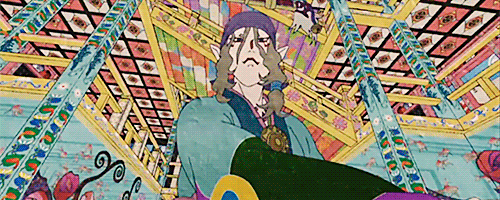
Watching Mononoke was quite the experience. First, because of how the cases were presented, dividing the stories into ‘arcs’ that usually took 2 or 3 chapters to finish, leaving 5 cases in total and each one more difficult to resolve than the one before. Also, and its more of note aspect was the surrealistic animation that Mononoke had, playing with the patterns, colors and textures in the background, giving an overwhelming sensation of a moving ‘scroll painting’ to the scenery, accompanying the madness that the mononoke created over the people they tormented in the series. This visual surrealism was also enhanced with an esoteric soundtrack, which also added to the building of the creepy atmosphere the creators wanted to transmit to the audience.
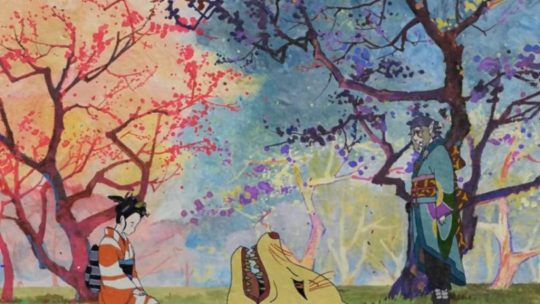
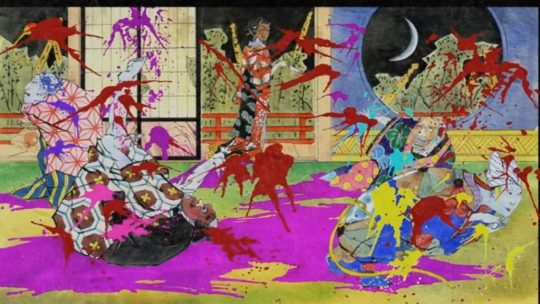
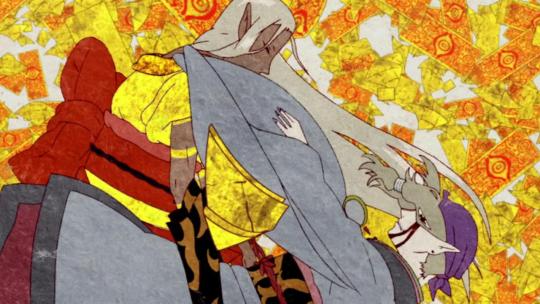
To put it simple, Mononoke is complete work of art made anime. And I hope that, whoever reads this post, can do themselves a favor and watch it as soon as possible. Trust me, you won’t be disappointed.

Last year it was announced that there would be a new movie of Mononoke being released this 2023, but it seems it got delayed due to the scandals in which Kusuriuri’s voice actor, Takahiro Sakurai (who was the seiyuu for Suguru Geto in Jujutsu Kaisen, Suzaku in Code Geass and many other popular anime) was involved. So, we’ll have to wait for news about the releasing of a new story of Mononoke.

(I'll leave the link to the full opening theme so you can enjoy it, it's very catchy! https://www.youtube.com/watch?v=urg-avD8p3Q) - Francisca Rivera C.
4 notes
·
View notes
Text
Animation Skills "Audio Project" Part 5


I started working on the camera in Paint, first I drew the background and sketch in Clip Studio and then I realized that without Paint I couldn't make the camera work, so after that I dumped it all into Paint and started working on the animation and the camera and I did the same with the next scene where it also has a movement with the camera.



I also used chromakey to speed up the animation process in this way and have at least a normal level of quality and animation.
The finished scene is below

So I'm going to keep working like this until I finish it, and when I'm close to finishing the animation, I'll start making sounds for this project, so I think I'm doing okay with that.
Research Element 10
Exaggeration
Exaggeration in animation is a technique used to amplify actions, expressions, or characteristics beyond realistic limits to make them more dynamic and expressive. Animation allows artists to bring all manner of characters and worlds to life in visually stunning ways.
For example, when animating a walk cycle, an animator may exaggerate the up-and-down bobbing movement to make the walk silly and comedic. They can make the head and torso sway wildly, extend the leg motions further than normal, and add quick bouncing to the steps. Or they may exaggerate a sad facial expression by making a character’s eyes extra large and luminous. The eyebrows angled sharply upward, and the frown very wide and pronounced. This principle applies to all aspects of animation, like characters, objects, and environments. they can all be exaggerated for added interest.

Hayao Miyazagi

Miyazaki Hayao (1941) is an influential Japanese anime director whose lyrical and allusive works have won both critical and popular acclaim. His notable films include Princess Mononoke (1997), Spirited Away (2001), Howl’s Moving Castle (2004), and The Boy and the Heron (2023).
After graduating from the Faculty of Economics at Gakushuin University in Tokyo in 1963, he was hired as a novice animator at Toei Animation, a division of Toei Studio and Asia's largest animation producer. While working at Toei, he met fellow animators Takahata Isao and Tata Akemi. The former became a lifelong friend, colleague, and business partner, and the latter, after a year-long courtship, became his wife. Miyazaki rose through the ranks at Toei, working on projects such as the television series Okami shōnen Ken (Wolf Boy Ken) and Takahata's feature directorial debut Taiyo no oji: Horusu no daibōken (1968; The Little Norwegian Prince).
After leaving Tōei in 1971, Miyazaki and Takahata continued to work at various studios throughout the 1970s. Among the most prominent works of this period are the short films Panda kopanda (Panda! Go, Panda!) and Miyazaki's first feature film, Rupan sansei: Kariosutoro no shiro (1979; Lupin III: Castle of Cagliostro), an adventure story about the gentleman thief Lupin and his compatriots.
Miyazaki's individual style became even more apparent in Kaze no tani no Naushika (Nausicaa of the Valley of the Wind), a monthly manga strip (Japanese cartoon) he wrote for Animage magazine. The story follows the journey of Nausicaa, a princess and warrior who does not want to fight, through an ecologically devastated world. The success of the cartoon inspired a movie of the same name (released in 1984) and pushed Miyazaki and Takahata to a more permanent partnership. Together they founded Studio Ghibli in 1985.

Studio Ghibli has overall received seven Oscar nominations, with two wins.
0 notes